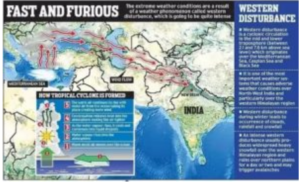In News
- With the approaching winter, minimum temperatures in the national capital have trended downward over the last due to the arrival of northwesterly winds called Western Disturbances.
What is Western Disturbances?

- Western Disturbances develop in the mid latitude region (north of the Tropic of Cancer), not in the tropical region, therefore they are called as mid latitude storms or extra-tropical storms.
- Extra-Tropical Cyclones are also called as winter storms and blizzards.
- Western Disturbances are low pressure systems, embedded in western winds (westerlies) that flow from west to the east.
- It is a term coined by an Indian Meteorologist for the weather phenomenon which is propagated from the West.
- The phrase Western Disturbance was first used in published literature in 1947. However, its precursor Winter Disturbance was coined earlier in 1931.
About Western Disturbance
- A western disturbance is an extratropical storm originating in the Mediterranean region that brings sudden winter rain to the northwestern parts of the Indian subcontinent.
- It is a non-monsoonal precipitation pattern driven by the westerlies.
- The moisture in these storms usually originates over the Mediterranean Sea, the Caspian Sea and the Black Sea.
- Extratropical storms are global phenomena with moisture usually carried in the upper atmosphere, unlike their tropical counterparts where the moisture is carried in the lower atmosphere.
- In the case of the Indian subcontinent, moisture is sometimes shed as rain when the storm system encounters the Himalayas.
- Western disturbances are more frequent and strong in the winter season.
Arrival in India
- Western Disturbances begin is a low pressure system that originates in the Mid- latitude region near the Atlantic ocean and Europe.
- The low pressure typically forms over the Mediterranean Sea and travels over Iran, Iraq, Afghanistan and Pakistan before entering India loaded with moisture.
- These moisture laden western disturbances eventually come up against the himalayas and get blocked, as a consequence, the moisture gets trapped and precipitation is shared in the form of snow and rain over Northwest India and sometimes, other parts of North India.
- An average of 4-5 western disturbances form during the winter season and the rainfall distribution and amount varies with every western disturbance.
- The word ‘Western’ refers to the direction from which they originate with regard to India.
- The word ‘disturbance’ is used because the air within the low pressure systems tends to be unstable or disturbed.
- Sometimes, when western disturbances become more intense in the Indian Region, they can extend even upto 15 degree north, resulting in rainfall upto north Maharashtra, Gujarat and the entire Madhya Pradesh to the south.
Their significance
- Western disturbances, specifically the ones in winter, bring moderate to heavy rain in low-lying areas and heavy snow to mountainous areas of the Indian Subcontinent.
- They are the cause of most winter and pre-monsoon season rainfall across northwest India.
- Precipitation during the winter season has great importance in agriculture, particularly for the rabi crops.
- Wheat among them is one of the most important crops, which helps to meet India’s food security. An average of four to five western disturbances forms during the winter season.
- The rainfall distribution and amount vary with every western disturbance.
Extra-tropical cyclone
- An extratropical cyclone is also called a temperate cyclone.
- It is developed in mid and high latitude beyond the tropic means between 30 to 60-degree latitude in both hemispheres.
- The main cause of the development is the formation of the front mainly occluded front.
Stage of formation of the temperate cyclone
- Initially, the front is stationary; with no encroachment by either of cold and warm masses.
- Later, warm air starts blowing from the south, and cold air blows from the north.
- In the frontal areas, pressure drops.
- Warm air moves northwards, and cold air moves southward, anticlockwise wise motion starts around low-pressure areas, is called an extratropical cyclone.
- Warm air rises over cold areas, cumulonimbus clouds developed along the front.
- The cold front moves faster than the warm front and ultimately the cold front overtakes a warm front and completely lifts over it and the occluded front forms and Cyclone ends.
- Temperature inversion atmospheric conditions occur with stable atmospheric conditions after extratropical cyclone ends
















